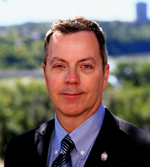 |
Last month, Alberta’s new Premier, Hon. Jim Prentice, announced the launch of a comprehensive review of health care in our province’s rural communities.
A three person panel has been asked to identify rural Alberta communities that need attention, and following a review of existing services and facilities, in consultation with regional Health Advisory Councils, is to report back to the Minister of Health within 90 days with its findings.
As the executive director of RPAP | Health Workforce for Alberta, a provincially-funded organization that supports the recruitment and retention of physicians for rural Alberta communities, I have been asked on several occasions recently: “What do you think?”
When it comes to attracting and keeping healthcare professionals in our rural and regional centres, any efforts to enhance the system is a good thing.
The truth is the healthcare system works pretty good most of the time. We are blessed to live in a province where there is no shortage of resources to address our healthcare shortcomings.
Rural Alberta possesses vibrant communities that work together with dedicated healthcare professionals, and health partners like RPAP on a local and provincial level to build healthy and sustainable places to live.
Physician salaries are competitive. As a result, there is no shortage of recruits from Canada and overseas coming to Alberta to practise medicine.
On the home front, the number of physicians graduating from Alberta’s faculties of rural medicine has increased substantially since 2000, and most are staying in the province once they begin practising. There are also increased numbers of nurses and other practitioners being admitted into post-secondary programs, many of whom are choosing to return to rural.
The supply side of the equation is solid: The challenge is one of distribution.
It isn’t just a matter of “if we build it, they will come”. There are many nursing and medicine jobs in rural Alberta that remain unfilled indefinitely.
Over the 90 day review period, the challenge will be to identify the health services that we offer in rural communities.
The panel will need to determine what kind of health care system we need practitioners to work within. Depending on what it decides regarding a cogent system of long-term care, community primary care and acute care services, we then need to ask: “how do we better distribute the healthcare workforce to areas of need in support of this health care delivery system?”
With a rural practice often consisting of only a handful of doctors, nurses and other practitioners, we also need to ensure physicians outside (and inside) of urban centres are linked together as part of a supportive community of practice. For this community to be effective, it needs to be properly supported and accountable to a connected provincial healthcare system.
It’s not just about getting a practitioner in your community – it’s about attracting the right kind of practitioner. Beyond the attractiveness of a hospital or clinic, factors such as accommodation, education, and career opportunities for spouses and partners, often make the final determination as to whether a community lands a physician, or not.
Quality healthcare exists outside of Edmonton and Calgary. The key to success is placing the right resources in the right places. This will ensure that practitioners live and work in the communities where their skills and services are most greatly needed.
David Kay is the Executive Director of RPAP | Health Workforce for Alberta.
